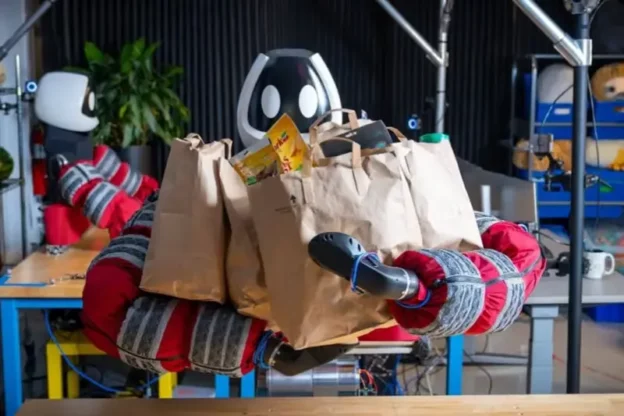Punyo, Toyota’ s new soft robot is inspired by human ergonomics to manipulate objects.
The Toyota Research Institute (TRI) has unveiled Punyo, a robotic research platform whose design is inspired by the way we humans use our full bodies to lift bulky objects. Unlike other humanoid robots that focus on the use of hands, Punyo integrates arms, chest and shoulders into its object manipulation mechanisms.
About Toyota’s new soft robot
Punyo stands out not only for its friendly and welcoming aesthetics, but also for its functional “sweater”, which is made of adherent materials that provide a flexible layer over the robot’s metal skeleton and is equipped with touch sensors that allow you to accurately perceive what you are embracing, whether it is a person or an object.
The robot also has a pair of limbs that Toyota calls “legs”, although they look more like inflatable and deformable pads. These legs, when they come into contact with an object and deform, allow the robot to confirm the touch thanks to internal dot patterns that are monitored by cameras.

In addition, Punyo’s arms are equipped with 13 air bladders extending from the shoulder to the wrist, which can be individually adjusted in pressure to achieve the optimal stiffness according to the activity being performed by the robot.
Using teleoperation, TRI robotics specialists have been training Punyo to handle various large objects. This training includes interesting loading techniques, such as placing a jug of water over its shoulder and holding it in place from above, demonstrating more natural object manipulation compared to other robots.
An innovative proposal in soft robotics
In September, Toyota showed a remarkable breakthrough in robotic learning, where robots were taught how to perform dozens of kitchen tasks with just a few examples, and then, through a broadcast policy learning system, the robots practiced the tasks in simulation for a few hours, managing to replicate them flexibly and autonomously.
The type of AI learning process through a diffusion policy learning system is being applied in Punyo, with the possibility of adjusting variables such as the fidelity with which example movements are tracked or the priority given to aspects such as speed, efficiency or the importance of performing the task correctly.
The future of robotics in domestic environments
This new approach in soft robotics could be particularly relevant in the domestic environment, where safe and natural interaction with humans and the environment is crucial. Although Punyo’s technology will not be applicable in all scenarios, its ability to manipulate objects in a similar way to how we people would suggest a future where robots could take on a more active and useful role in our daily lives.
Don’t miss any of our posts and follow us on social media!
Inspenet.com YouTube LinkedIn Facebook Instagram
Source and photo: newatlas.com
Video: Toyota Research Institute


